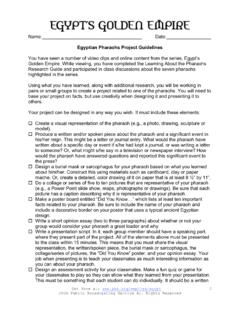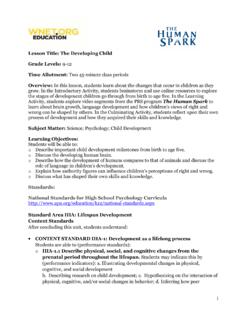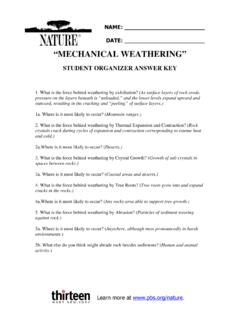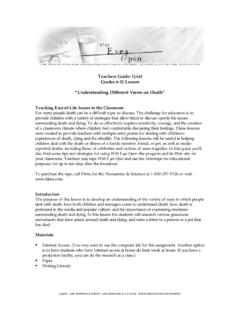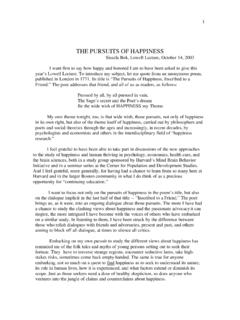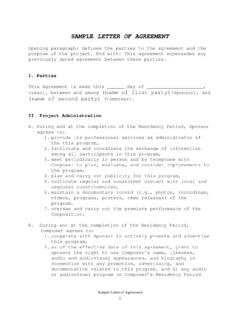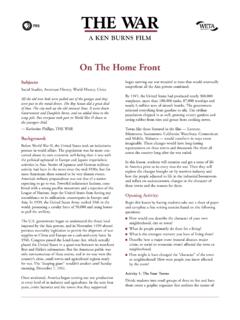Transcription of LESSON PLAN: GLOBAL WARMING - PBS
1 LESSON PLAN: GLOBAL WARMING LESSON Objectives By the end of this LESSON , students will: 1. Form definitions of the greenhouse effect based on prior knowledge, class discussion, and viewing diagrams. 2. Participate in group brainstorming sessions and class discussions related to the impact of the greenhouse effect and GLOBAL WARMING . 3. Analyze GLOBAL WARMING diagrams and resources to obtain a clear understanding of this scientific process . 4. Hypothesize about the effects of GLOBAL WARMING on the climate and the world's populations. 5. Conduct research using a variety of primary sources to explore perspectives in the GLOBAL WARMING debate. 6. Complete a Venn Diagram that compares various points of view on GLOBAL WARMING issues. 7. Take a position on GLOBAL WARMING and support this viewpoint with reasons, facts, and examples gathered during LESSON activities. 8. Create a project that supports their point of view about GLOBAL WARMING issues.
2 Related National Standards These standards are drawn from "Content Knowledge," a compilation of content standards and benchmarks for K-12 curriculum by McRel (Mid-continent Research for Education and Learning), at Science Standard 1: Understands atmospheric processes and the water cycle. Geography Standard 8: Understands the characteristics of ecosystems on Earth's surface. Standard 14: Understands how human actions modify the physical environment. Standard 16: Understands the changes that occur in the meaning, use, and distribution and importance of resources. Standard 18: Understands GLOBAL development and environmental issues. Health Standard 2: Knows environmental and external factors that affect individual and community health. World History Standard 44: Understands the search for community, stability, and peace in an interdependent world. Language Arts Writing, Standard 4: Gathers and uses information for research purposes.
3 Reading, Standard 7: Uses reading skills and strategies to understand and interpret a variety of informational texts. Listening and Speaking Standard 8: Uses listening and speaking strategies for different purposes. Standard 9: Uses viewing skills and strategies to understand and interpret visual media. Standard 10: Understands the characteristics and components of the media. Thinking and Reasoning Standard 1: Understands and applies the basic principles of presenting an argument. Standard 2: Understands and applies the basic principles of logic and reasoning. Standard 3: Effectively uses mental processes that are based on identifying similarities and differences. Standard 6: Applies decision-making techniques. Estimated Time to Complete LESSON Four or five 50-minute class periods, plus some time outside of class to complete the final project. Some of the in-class activities in this LESSON plan could be completed for homework, if preferred.
4 Materials Needed Internet access for research and viewing broadcasts, transcripts, podcasts, etc., from NOW and other online resources Access to content from three NOW broadcasts: The Heat Over GLOBAL WARMING Climate Change and the Media Senate Hearings God and GLOBAL WARMING Handout: GLOBAL WARMING Venn Diagram (PDF file) Handout: GLOBAL WARMING Project Ideas (PDF file) Backgrounder for Teachers Is human activity bringing about alarming GLOBAL WARMING scenarios and related catastrophes? Or is such thinking a myth brought about by flawed or incomplete science? Finding the answers to these questions has turned GLOBAL WARMING into a highly politicized and contentious issue. Until about 1960, most scientists thought it implausible that humans could actually affect average GLOBAL temperatures. (See NOW's History of GLOBAL WARMING at ) Today, most scientists agree that Earth's temperature has risen over the past century and that carbon dioxide is one of the primary greenhouse gases that contribute to GLOBAL WARMING .
5 Disagreement persists, however, over whether or not GLOBAL climate change is a normal environmental variation, and over how big of a problem GLOBAL WARMING could become for the planet. Amidst such controversy, world leaders have met and outlined legal rules, known as the Kyoto Protocol, to limit the emissions of greenhouse gases. One hundred forty countries that collectively represent of greenhouse gas emissions worldwide have ratified the Kyoto Protocol. The United States does not support the Kyoto Protocol and disagrees with a number of its provisions. Instead, the is funding additional scientific research on the causes and effects of GLOBAL WARMING , encouraging climate change technology research and development efforts, looking at how its own federal and state laws can regulate greenhouse gas emissions in the , backing the research and development of renewable energy sources, and pursuing other strategies that it believes will address GLOBAL climate change without major upsets to the economy.
6 Assumed Student Prior Knowledge Students should be familiar with the terms, " GLOBAL WARMING ," the "greenhouse effect," and "greenhouse gases." Also, they should be aware that the is a leading producer of greenhouse gas emissions that contribute to GLOBAL WARMING . Teaching Strategy Part 1: Reviewing the Facts: What is The Greenhouse Effect? (30 minutes) 1. Before class begins, post the term, "greenhouse effect" where students can see it. 2. To begin the class, ask students to think without talking about a definition for the greenhouse effect. Give them a minute to formulate their ideas and then have them write down their definitions so they can share them. 3. At the end of the allotted time, ask students to share their definitions with one or two other students sitting nearby and compare the similarities and differences in their definitions. Allow a few minutes for student pairs or groups to then combine their definitions into one that they believe is the most accurate.
7 4. Begin a class discussion by asking several pairs/groups to share their definitions of the greenhouse effect. 5. Next, show students a Flash animation (found at the Environmental Protection Agency's Web site: ) that accurately describes the greenhouse effect and how it likely contributes to GLOBAL WARMING . You might have students take turns reading the dialogue balloons for the characters shown on the site. Alternatively, the EPA Web site provides a simple diagram with text explanation of the greenhouse effect at: Ask students to make any corrections to their definitions based on what they've learned. Part 2: Making Predictions about the Effects of GLOBAL WARMING (20 minutes) With an understanding of the greenhouse effect and GLOBAL climate change, students can now make predictions about the potential impact of GLOBAL WARMING . 1. Ask students to hypothesize about how the world's climate could change over the next 100 years if humans do nothing to limit the levels of their greenhouse gas emissions.
8 Have them also make predictions about the effects such climate changes could have on humans. 2. Working in pairs, small groups, or as a class, students should brainstorm a list of their ideas related to these questions. Each student should record a copy of the list in order to refer back to it later in the LESSON . Part 3: Comparing Points of View on GLOBAL WARMING (90 minutes) 1. Begin by discussing the fact that not everyone agrees about GLOBAL WARMING and climate change. Use content from three NOW broadcasts to illustrate some of the controversy surrounding GLOBAL WARMING . The Heat Over GLOBAL WARMING Climate Change and the Media Senate Hearings God and GLOBAL WARMING 2. Pose the following question: In your opinion, has human activity caused the world's climate to change over the past 100 years? 3. Distribute copies of the Handout: GLOBAL WARMING Venn Diagram (see Materials Needed) and review the directions for completing the diagram.
9 4. Using the resources listed on the handout, have students work in pairs, small groups, or as a class to complete the graphic organizer. Encourage students to examine at least 4 of the programs listed as a means of gathering information representative of a number of different sources and points of view. Students should use at least two programs from the NOW Programs list and at least 2 resources from the Other GLOBAL WARMING Resources list. As students research, direct them to note specific facts and use the back of the sheet to note more in-depth details and cite their sources. This information will be used in class discussion as well as in a later project. Part 4: Forming Opinions about GLOBAL WARMING (30 minutes) Now that students have explored a variety of perspectives on GLOBAL climate change, they will take a position on the issue and support it with data from their previous research. 1. Ask students to write 2-3 persuasive paragraphs to answer the following questions: In your opinion, is GLOBAL WARMING an imminent world threat?
10 Why or why not? Based on your opinion, what actions do you believe should be taken to address the GLOBAL WARMING issue? Remind students to support their opinions with specific information from the brainstorming lists created in Part 2 and their completed Venn Diagrams from Part 3. 2. Once students have organized their thinking on paper, give them the opportunity to share their opinions with at least one other student in class. Do not allow discussion or debate; rather, allow students to practice sharing what they have written so that others can hear the reasons behind their positions. Part 5: Final Project (45 minutes, plus outside preparation time) 1. Invite students to choose a project from the Handout: GLOBAL WARMING Project List (see Materials Needed). Alternatively, students could design a project of their own with teacher approval. The goal of the project is for students to create something substantive that they can use to share their positions on GLOBAL WARMING and to increase awareness about its related issues.
